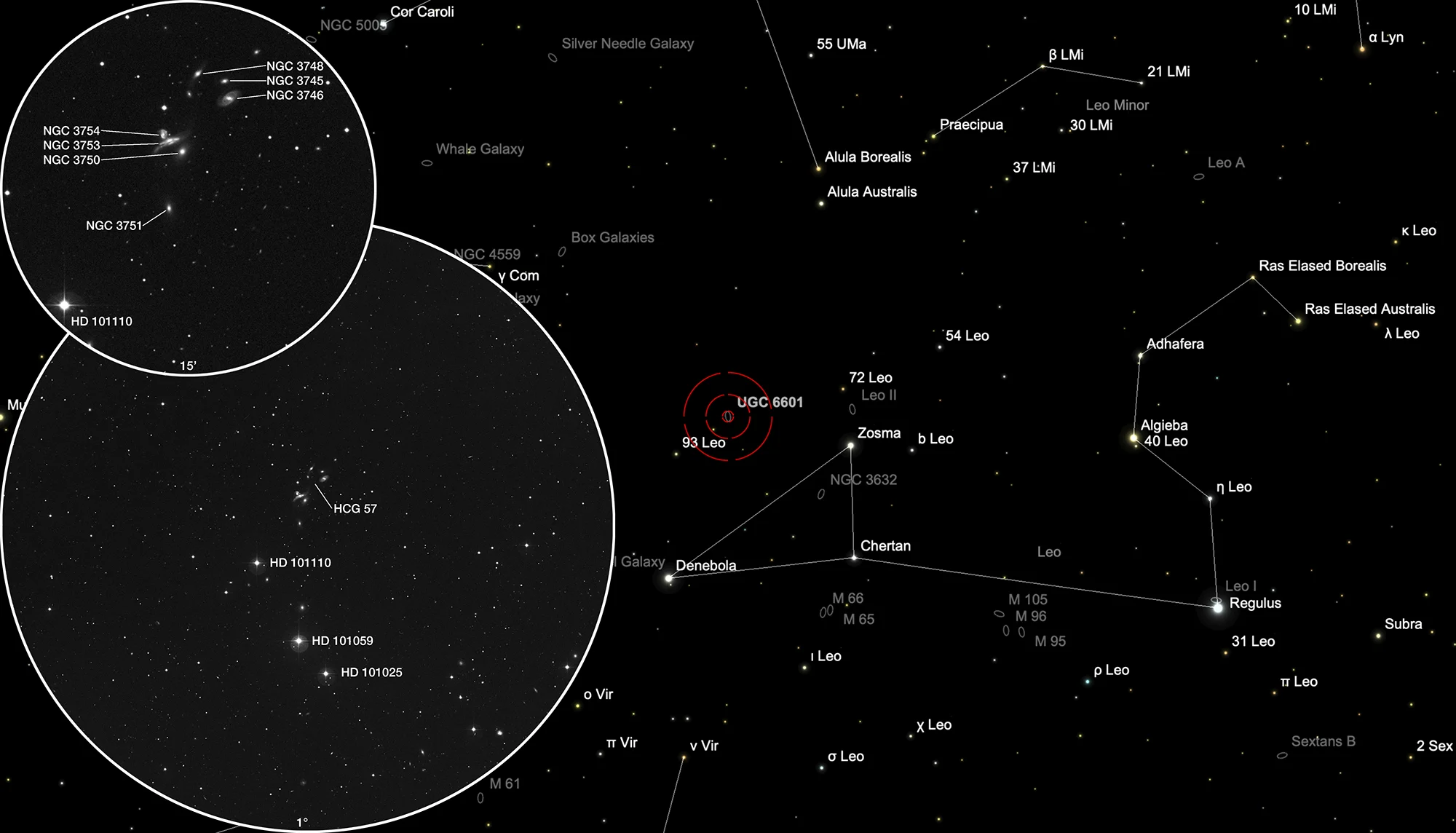Copelands Septet (Hickson 57)

History
This group of galaxies was discovered on 9 February 1874 by the British astronomer Ralph Copeland with Lord Rosse's 72 inch reflecting telescope in Birr Castle. [277]
Physical Properties
The visual magnitudes between 13.6 mag to 15.2 mag challenge larger amateur telescopes from approx. 14 inches to a duel. Especially the weaker galaxies of the seven are not easy to capture. NGC 3745 is one of the most difficult galaxies with 15.2 mag. NGC 3746, NGC 3748, NGC 3750, NGC 3751 and NGC 3753 have visual magnitudes of 14.2 mag, 14.8 mag, 13.9 mag, 13.9 mag and 13.6 mag. The galaxy NGC 3754, which is close to NGC 3753, is another tough nut to crack with 14.3 mag.
| Name | RA | Dec | Type | bMag | vMag | B-V | SB | Dim | PA | z | D(z) | Dreyer Description | Identification, Remarks |
|---|---|---|---|---|---|---|---|---|---|---|---|---|---|
| NGC 3745 | 11 37 44.5 | +22 01 16 | Gx (E-S0) | 16.2 | 15.2 | 1.0 | 12.0 | 0.4 × 0.2 | 102 | 0.031565 | 133.3 | pB, pS, R | MCG 4-28-4; VV 282; Arp 320; HCG 57G; Copeland septet |
| NGC 3746 | 11 37 43.6 | +22 00 35 | Gx (SBab) | 15.0 | 14.1 | 0.9 | 13.3 | 1.1 × 0.5 | 126 | 0.030094 | 127.1 | pB, pS, R | UGC 6597; MCG 4-28-5; CGCG 127-6; VV 282; Arp 320; HCG 57B; Copeland septet |
| NGC 3748 | 11 37 49.1 | +22 01 35 | Gx (SB0) | 15.8 | 14.8 | 1.0 | 12.6 | 0.7 × 0.4 | 132 | 0.029407 | 124.2 | pB, pS, R | MCG 4-28-7; CGCG 127-7; VV 282; Arp 320; HCG 57E; Copeland septet |
| NGC 3750 | 11 37 51.6 | +21 58 29 | Gx (E-S0) | 14.9 | 13.9 | 1.0 | 12.1 | 0.5 × 0.4 | 132 | 0.030291 | 127.9 | pB, R, cbM, 1st of 3 in line | MCG 4-28-8; CGCG 127-9; VV 282; Arp 320; HCG 57C; NPM1G +22.0340; Copeland septet |
| NGC 3751 | 11 37 53.9 | +21 56 13 | Gx (E-S0) | 15.3 | 14.4 | 0.9 | 12.0 | 0.5 × 0.2 | 9 | 0.031335 | 132.3 | F, L, E 45° | UGC 6601; MCG 4-28-9; HCG 57F; Copeland septet |
| NGC 3753 | 11 37 53.8 | +21 58 53 | Gx (Sab) | 14.5 | 13.7 | 0.8 | 13.4 | 1.7 × 0.5 | 117 | 0.029110 | 122.9 | pB, pL, 2nd of 3 in line | UGC 6602; MCG 4-28-10; CGCG 127-12; VV 282; Arp 320; HCG 57A; Copeland septet |
| NGC 3754 | 11 37 55.0 | +21 59 08 | Gx (Sb) | 15.1 | 14.3 | 0.8 | 12.4 | 0.4 × 0.3 | 18 | 0.029944 | 126.4 | vF, R, 3rd of 3 in line | MCG 4-28-11; CGCG 127-12; VV 282; Arp 320; HCG 57D; IRAS 11352+2216; Copeland septet |
Finder Chart
The galaxy septet is located in the constellation Leo. At the back left of Leo, near δ Leonis (Zosma) on the extension of two stars with 4.5 mag (93 Leonis) and 5.2 mag (92 Leonis) the septet can be found. In the large-field eyepiece (1° and more true field of view) a row of three 9th to 8th magnitude stars points the way to the galaxy group. On 14 March it is in opposition to the Sun and crosses the meridian at local midnight.
Visual Observation
350 mm Aperture: The somewhat distant galaxy NGC 3751 can be easily and reliably recognized with a 14-inch device with averted vision. In the first group of three with NGC 3750/53/54, verifying the faint galaxy NGC 3754 is difficult because it almost merges with the neighboring galaxy NGC 3753. In the second group of three with NGC 3746/45/48 the middle galaxy NGC 3745 with 15.2 mag is at the same time the weakest and most difficult galaxy.
To see all seven galaxies, you need an extremely transparent sky and a larger amateur telescope. With an aperture of 14 inches, the lower limit is certainly exhausted. More aperture makes all galaxies more safely accessible and verifiable. [192]
